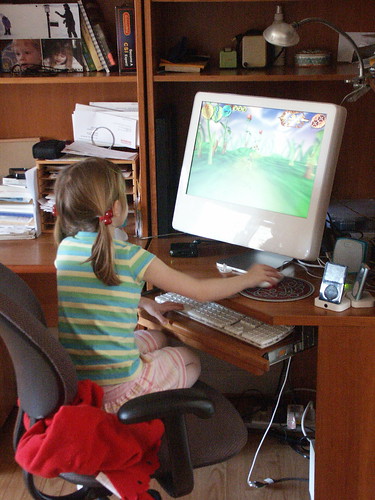By David Luke.
I have had an interest in programming and creating games since I purchased a BBC Model A in the 80’s (the good old days!). However, it was only recently that I have actively promoted the introduction of games making into the ICT curriculum.
Two factors prompted my decision. Firstly, the introduction of the renewed ICT framework in spring 2008, which introduced learning objectives around ‘sequencing instructions’ and opened up options other than control. Secondly, the availability of easy to use games making software, which had the capacity to build games with a very professional feel.
 Not just a boys' game! Photo by Paul http://www.flickr.com/photos/crimfants/My early research into games making software led me to conclude that there were two very good options, Mission Maker (Immersive Education) and Games Maker 7 (YOYOGames). As a result of further investigation I decided to go with Games Maker 7, the key reasons being ease of use, price per install, and pupils could also download it for free to use at home.
Not just a boys' game! Photo by Paul http://www.flickr.com/photos/crimfants/My early research into games making software led me to conclude that there were two very good options, Mission Maker (Immersive Education) and Games Maker 7 (YOYOGames). As a result of further investigation I decided to go with Games Maker 7, the key reasons being ease of use, price per install, and pupils could also download it for free to use at home.
In the summer term of 2008 we launched a training package which included skills training and a full day developing a scheme of work, involving representatives from half of our secondary and middle schools. The scheme of work was then introduced to all our secondary and middle schools, at the following Subject Leader Development network, with an understanding that they could then use it as a basis for development in their own departments, with additional support from the school improvement consultants, if required.
A number of schools requested the additional consultant support, including one of the middle schools I normally supported. From the initial meeting with the ICT Subject leader it was clear that there was an opportunity for an action research project around a number of aspects of teaching and learning, including the impact of delivering the Games Maker project as a course through the VLE. The questions we agreed to try and answer were:
- Games playing is predominantly a boys’ activity1,2 (see references at the end of this article); therefore, will learning activities around making a game have a negative impact on girls’ learning?
- Will a problem-solving approach to games making engage the pupils and accelerate learning?
- How will a blended learning approach, including face to face and VLE delivery of the course, impact on learning?
Target Audience:
Year 7 (11-12 years) and/or Year 8 (12-13 years) pupils in mixed ability groups in a co-educational environment.
Planning Stage:
- The initial stage was to agree the minimum criteria that the pupils’ games would be expected to meet. They were:
- A main character that moved in the four main directions.
- No character could pass through the maze walls.
- A main character that would face the direction it was moving.
- Objects that had to be collected to complete a level.
- Doors that only opened when all the objects had been collected.
- Aliens/Monsters that would kill the main character on contact.
- Some Aliens/Monsters that could move vertically and others horizontally.
- At least three different levels of increasing difficulty.
- Agreeing the minimum specification for the games led to identification of the key skills pupils would need to learn in order to have the opportunity to meet the above criteria. From this information the resources were developed.
- The tasks were then created as learning modules on the VLE, each learning module consisted of a number of pages and attached assignments to complete and upload, which could then be marked online by the teacher.
The five tasks were as follows:
Task 1 - What makes a Good Game? In which pupils played three games to identify good points and areas for development, apply existing criteria and develop their own additional criteria.
Task 2 - How is a game made? Consisting of seven problem solving activities to develop the basic skills.
These resources were created as learning module pages on the VLE, each page consisting of a downloadable partially working game, some basic instructions and, when required, downloadable sprites and sounds.
The pupils were asked to download and play the game, discover what was working and the code that made it work. They were then asked to either add extra instructions, correct existing instructions or both.
Task 3 - Planning the Game! One lesson in which the pupils plan the game using a downloadable template.
Task 4 - Improving the game! A dip in selection of activities which pupils can use to improve the game e.g. scoring systems.
Task 5 - Destroy the Beef Burgers! As task 4, but specific to creating a shooting element to their game.
The initial development of the resources were carried out in conjunction with an ICT subject specialist in a secondary school, but the VLE course was specifically created to trial with year 8 pupils in a middle school.
Trial audience:
Year 8 middle school pupils grouped for ICT into three sets based on their mathematical ability. In total there were 90 pupils with a gender breakdown of 52 boys and 38 girls. Each set had a total of 1.5 hours per week with the course lasting 10 weeks.
Course delivery:
Sets 1 and 3 had input from both the consultant and the subject leader, whereas set 2 only had input from the subject leader. The consultant supported the first two lessons, followed by the fourth and seventh lessons. Lesson seven was used by the consultant to introduce the purpose of the online poll, which was to be the main source of feedback.
Lesson one introduced the idea of a VLE course and explained Task 1, which the pupils then completed independently with support where required. Pupils were asked to upload the two assignments which were then marked online with feedback.
Lessons two and three concentrated on the problem solving activities in task 2, the majority of pupils working independently through the activities. A number of pupils completed these activities within the time and therefore planned the game in advance of lesson five.
Lessons four/five concentrated on the planning their game, with the plan being uploaded for marking.
Lessons five onwards pupils developed their own games using the activities from task 4 to enhance their games.
Whole class inputs from the subject leader and/or consultant were used to set the scene for each lesson and expected outcomes for the different groups of pupils. Small group inputs focussed on specific issues with which the pupils required additional support.
A small number of boys had already downloaded Game Maker at home and had partially developed games prior to this course starting. They were provided with the opportunity to dip into both tasks 2 and 4 to support further development of their games and more or less worked independently from the other pupils.
Key findings:
Based on 78 of the 90 pupils answering the poll.
Significantly 86% of the pupils enjoyed the course, therefore, only 10 pupils did not like the course.
91% of the pupils felt that the resources were at least useful or very useful, indicating that the way the course was structured supported their learning.
83% of pupils felt that their understanding of the games maker software was good to excellent as a result of the course. Indicating that the strategy for delivering the course around problem solving had been effective. This can also be seen in the quality of the games produced.
83% of the pupils also felt that the game had matched up to their original expectations.
Finally, we used the poll to assess if their games had met some of the key criteria we set out in the planning stage.
Interestingly, 83% of pupils said they had a character that moved in all four directions, but in reality they all did. It would be interesting to investigate why 13 pupils did not say yes to this question: could it be that they felt it was not their own work because of the amount of support they had received?
In Conclusion:
We set out to try and answer the following three questions.
- Games playing is predominantly a boys’ activity, therefore, will learning activities around making a game have a negative impact on girls’ learning?
- Will a problem solving approach to games making engage the pupils and accelerate learning?
- How will a blended learning approach, including face to face and VLE delivery of the course, impact on learning?
I would not try to suggest that we have succeeded in providing the answers as the data is limited to one environment, but we have at least have detected some trends worth investigating more fully.
- There was no evidence of any negative impact on the girls’ learning; in fact they produced some of the most sophisticated games. Even if the negative answers to the questions, concerning enjoying the course and understanding of games maker, were all provided by girls this would only account for less than a third of the girls in the year group. For future research a question on gender would help to provide a more comprehensive analysis.
- It is difficult to provide a comprehensive answer to this question, but the fact that 86% enjoyed the course and 91% felt that the resources were at least useful or very useful. would indicate engagement. It would have been useful to compare usage of the resources with the level of understanding of Games Maker achieved and the quality of the final game i.e. did the pupils who used the resources produce the most sophisticated games?
- There is no data from our poll that addresses this question directly, however from my direct observations of pupils using this course and those of similar ability in other schools taught through demonstrations and then provided with individual or group support, progress was significantly faster. The pupils were able to proceed to development stage more quickly and, therefore, had more time to design and create more sophisticated games.
Acknowledgements:
Chris Brady, for his work in developing a number of the problem solving activities and delivering the course.
Jon Ingram, for his support in delivering the course and providing the evidence to judge impact.
References:
- Study Examines Video Game Play Among Adolescents Hope M. Cummings; Elizabeth A. Vandewater Arch Pediatr Adolesc Med. July2007;161:684-689.
- Parental Perceptions of Computer-Based Gaming Technology: An Evaluation of Children's Leisure Pursuits in the Computer Age Journal article by Belinda Clayton; Australian Journal of Early Childhood, Vol. 28, 2003
This article first appeared in Computers in Classrooms. That newsletter has been replaced by Digital Education. David Luke was an ICT Consultant with Kirklees at the time he wrote the article.
Your newsletter editor is hard at work sifting through the submissions for Digital Education, the free newsletter for education professionals. Have you subscribed yet?
Read more about it, and subscribe, on the Newsletter page of the ICT in Education website.
We use a double opt-in system, and you won’t get spammed.






